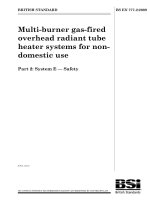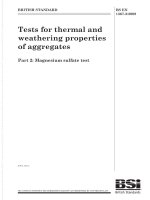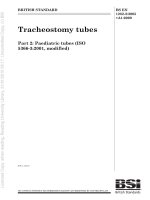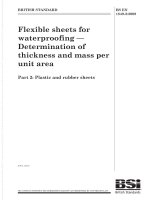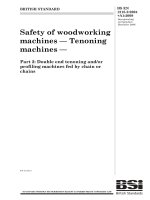Bsi bs en 62007 2 2009
Bạn đang xem bản rút gọn của tài liệu. Xem và tải ngay bản đầy đủ của tài liệu tại đây (1.85 MB, 44 trang )
BS EN 62007-2:2009
BSI British Standards
Semiconductor optoelectronic
devices for fibre optic system
applications —
Part 2: Measuring methods
NO COPYING WITHOUT BSI PERMISSION EXCEPT AS PERMITTED BY COPYRIGHT LAW
raising standards worldwide™
BRITISH STANDARD
BS EN 62007-2:2009
National foreword
This British Standard is the UK implementation of EN 62007-2:2009. It is
identical to IEC 62007-2:2009. It supersedes BS EN 62007-2:2000 which is
withdrawn.
The UK participation in its preparation was entrusted by Technical Committee
GEL/86, Fibre optics, to Subcommittee GEL/86/3, Fibre optic systems and
active devices.
A list of organizations represented on this committee can be obtained on
request to its secretary.
This publication does not purport to include all the necessary provisions of a
contract. Users are responsible for its correct application.
© BSI 2009
ISBN 978 0 580 60074 6
ICS 31.080.01; 31.260; 33.180.01
Compliance with a British Standard cannot confer immunity from
legal obligations.
This British Standard was published under the authority of the
Standards Policy and Strategy Committee on 31 October 2009
Amendments issued since publication
Amd. No.
Date
标准分享网 www.bzfxw.com 免费下载
Text affected
BS EN 62007-2:2009
EUROPEAN STANDARD
EN 62007-2
NORME EUROPÉENNE
March 2009
EUROPÄISCHE NORM
ICS 31.080.01; 31.260; 33.180.01
Supersedes EN 62007-2:2000
English version
Semiconductor optoelectronic devices
for fibre optic system applications Part 2: Measuring methods
(IEC 62007-2:2009)
Dispositifs optoélectroniques
à semiconducteurs pour application
dans les systèmes à fibres optiques Partie 2: Méthodes de mesure
(CEI 62007-2:2009)
Optoelektronische Halbleiterbauelemente
für Anwendungen
in Lichtwellenleitersystemen Teil 2: Messverfahren
(IEC 62007-2:2009)
www.bzfxw.com
This European Standard was approved by CENELEC on 2009-02-01. CENELEC members are bound to comply
with the CEN/CENELEC Internal Regulations which stipulate the conditions for giving this European Standard
the status of a national standard without any alteration.
Up-to-date lists and bibliographical references concerning such national standards may be obtained on
application to the Central Secretariat or to any CENELEC member.
This European Standard exists in three official versions (English, French, German). A version in any other
language made by translation under the responsibility of a CENELEC member into its own language and notified
to the Central Secretariat has the same status as the official versions.
CENELEC members are the national electrotechnical committees of Austria, Belgium, Bulgaria, Cyprus, the
Czech Republic, Denmark, Estonia, Finland, France, Germany, Greece, Hungary, Iceland, Ireland, Italy, Latvia,
Lithuania, Luxembourg, Malta, the Netherlands, Norway, Poland, Portugal, Romania, Slovakia, Slovenia, Spain,
Sweden, Switzerland and the United Kingdom.
CENELEC
European Committee for Electrotechnical Standardization
Comité Européen de Normalisation Electrotechnique
Europäisches Komitee für Elektrotechnische Normung
Central Secretariat: avenue Marnix 17, B - 1000 Brussels
© 2009 CENELEC -
All rights of exploitation in any form and by any means reserved worldwide for CENELEC members.
Ref. No. EN 62007-2:2009 E
BS EN 62007-2:2009
EN 62007-2:2009
-2-
Foreword
The text of document 86C/868/FDIS, future edition 2 of IEC 62007-2, prepared by SC 86C, Fibre optic
systems and active devices, of IEC TC 86, Fibre optics, was submitted to the IEC-CENELEC parallel vote
and was approved by CENELEC as EN 62007-2 on 2009-02-01.
This European Standard supersedes EN 62007-2:2000.
EN 62007-2:2009 includes the following significant technical changes with respect to EN 62007-2:2000:
– descriptions related to analogue characteristics have been removed;
– some definitions and terms have been revised for harmonisation with other standards originating from
SC 86C.
The following dates were fixed:
– latest date by which the EN has to be implemented
at national level by publication of an identical
national standard or by endorsement
(dop)
2009-11-01
– latest date by which the national standards conflicting
with the EN have to be withdrawn
(dow)
2012-02-01
Annex ZA has been added by CENELEC.
__________
www.bzfxw.com
Endorsement notice
The text of the International Standard IEC 62007-2:2009 was approved by CENELEC as a European
Standard without any modification.
In the official version, for Bibliography, the following notes have to be added for the standards indicated:
IEC 61300
NOTE Harmonized in EN 61300 series (not modified).
IEC 61315
NOTE Harmonized as EN 61315:2006 (not modified).
ISO 1101
NOTE Harmonized as EN ISO 1101:2005 (not modified).
__________
标准分享网 www.bzfxw.com 免费下载
BS EN 62007-2:2009
-3-
EN 62007-2:2009
Annex ZA
(normative)
Normative references to international publications
with their corresponding European publications
The following referenced documents are indispensable for the application of this document. For dated
references, only the edition cited applies. For undated references, the latest edition of the referenced
document (including any amendments) applies.
NOTE When an international publication has been modified by common modifications, indicated by (mod), the relevant EN/HD
applies.
Publication
Year
Title
EN/HD
Year
IEC 60050-731
1991
International Electrotechnical Vocabulary
(IEV) Chapter 731: Optical fibre communication
-
-
IEC 60793 (mod)
Series Optical fibres
EN 60793
Series
IEC 60794
Series Optical fibre cables
EN 60794
Series
IEC 60874
Series Connectors for optical fibres and cables
EN 60874
Series
www.bzfxw.com
–2–
BS EN 62007-2:2009
62007-2 © IEC:2009
CONTENTS
FOREWORD...........................................................................................................................4
INTRODUCTION..................................................................................................................... 6
1
Scope ............................................................................................................................... 7
2
Normative references ....................................................................................................... 7
3
Terms, definitions and abbreviations ................................................................................ 7
4
3.1 Terms and definitions .............................................................................................. 7
3.2 Abbreviations .......................................................................................................... 8
Measuring methods for photoemitters ............................................................................... 8
4.1
4.2
4.3
4.4
4.5
4.6
4.7
4.8
4.9
5
Outline of the measuring methods ........................................................................... 8
Radiant power or forward current of LEDs and LDs with or without optical
fibre pigtails ............................................................................................................ 8
Small signal cut-off frequency (f c ) of LEDs and LDs with or without optical
fibre pigtails ............................................................................................................ 9
Threshold current of LDs with or without optical fibre pigtails ................................ 10
Relative intensity noise of LEDs and LDs with or without optical fibre pigtails ........ 12
S 11 parameter of LEDs, LDs and LD modules with or without optical fibre
pigtails .................................................................................................................. 13
Tracking error for LD modules with optical fibre pigtails, with or without
cooler .................................................................................................................... 15
Spectral linewidth of LDs with or without optical fibre pigtails ................................ 17
Modulation current at 1 dB efficacy compression (I F (1 dB) ) of LEDs .................... 18
www.bzfxw.com
4.10 Differential efficiency ( η d ) of a LD with or without pigtail and an LD module .......... 20
4.11 Differential (forward) resistance r d of an LD with or without pigtail ........................ 22
Measuring methods for receivers .................................................................................... 23
5.1
5.2
5.3
5.4
5.5
5.6
Outline of the measuring methods ......................................................................... 23
Noise of a PIN photodiode..................................................................................... 23
Excess noise factor of an APD with or without optical fibre pigtails ........................ 25
Small-signal cut-off frequency of a photodiode with or without optical fibre
pigtails .................................................................................................................. 27
Multiplication factor of an APD with or without optical fibre pigtails ........................28
Responsivity of a PIN-TIA module ......................................................................... 30
5.7
Frequency response flatness (ΔS/S) of a PIN-TIA module ...................................... 32
5.8
Output noise power (spectral) density P no, λ of a PIN-TIA module .......................... 33
5.9
Low frequency output noise power (spectral) density (P no , λ , LF ) and corner
frequency (f cor ) of a PIN-TIA module .................................................................... 35
5.10 Minimum detectable power of PIN-TIA module ...................................................... 36
Bibliography.......................................................................................................................... 38
Figure 1 – Equipment setup for measuring radiant power and forward current of LEDs
and LDs .................................................................................................................................. 8
Figure 2 – Circuit diagram for measuring small-signal cut-off frequency LEDs and LDs ........ 10
Figure 3 – Circuit diagram for measuring threshold current of a LD ....................................... 11
Figure 4 – Graph to determine threshold current of lasers..................................................... 11
Figure 5 – Circuit diagram for measuring RIN of LEDs and LDs ............................................ 12
Figure 6 – Circuit diagram for measuring the S 11 parameter LEDs, LDs and LD
modules ................................................................................................................................ 14
标准分享网 www.bzfxw.com 免费下载
BS EN 62007-2:2009
62007-2 © IEC:2009
–3–
Figure 7– Cathode and anode connected to the package of a LD.......................................... 15
Figure 8 – Output radiant power versus time ......................................................................... 16
Figure 9 – Output radiant power versus case temperature .................................................... 16
Figure 10 – Circuit diagram for measuring linewidth of LDs ................................................... 17
Figure 11 – Circuit diagram for measuring 1 dB efficacy compression of LDs ........................ 19
Figure 12 – Plot of log V 2 versus log I 1 ................................................................................. 20
Figure 13 – Circuit diagram for measuring differential efficiency of a LD ............................... 21
Figure 14 – Current waveform for differential efficiency measurement .................................. 21
Figure 15 – Circuit diagram for measuring differential resistance .......................................... 22
Figure 16 – Current waveform for differential resistance ....................................................... 23
Figure 17 – Circuit diagram for measuring noise of a PIN photoreceiver ............................... 24
Figure 18 – Circuit diagram for measuring noise with synchronous detection ........................ 25
Figure 19 – Circuit diagram for measuring excess noise of an APD....................................... 26
Figure 20 – Circuit diagram for measuring small-signal cut-off wavelength of a
photodiode............................................................................................................................ 28
Figure 21 – Circuit diagram for measuring multiplication factor of an APD ............................ 29
Figure 22 – Graph showing measurement of I R1 and I R2 ....................................................... 30
Figure 23 – Circuit diagram for measuring responsivity of a PIN-TIA module ........................ 31
Figure 24 – Circuit diagram for measuring frequency response flatness of a PIN-TIA
module.................................................................................................................................. 32
www.bzfxw.com
Figure 25 – Circuit diagram for measuring output noise power (spectral) density of a
PIN-TIA module under matched output conditions ................................................................. 34
Figure 26 – Circuit diagram for measuring output noise power (spectral) density of a
non-irradiated PIN-TIA module in the low frequency region ................................................... 35
Figure 27 – Graph of V m versus frequency ............................................................................ 36
Figure 28 – Circuit diagram for measuring minimum detectable power of a PIN-TIA
module at a specified bit-error rate (BER) or carrier-to-noise ratio (C/N) ................................ 37
–4–
BS EN 62007-2:2009
62007-2 © IEC:2009
INTERNATIONAL ELECTROTECHNICAL COMMISSION
____________
SEMICONDUCTOR OPTOELECTRONIC DEVICES
FOR FIBRE OPTIC SYSTEM APPLICATIONS –
Part 2: Measuring methods
FOREWORD
1) The International Electrotechnical Commission (IEC) is a worldwide organization for standardization comprising
all national electrotechnical committees (IEC National Committees). The object of IEC is to promote
international co-operation on all questions concerning standardization in the electrical and electronic fields. To
this end and in addition to other activities, IEC publishes International Standards, Technical Specifications,
Technical Reports, Publicly Available Specifications (PAS) and Guides (hereafter referred to as “IEC
Publication(s)”). Their preparation is entrusted to technical committees; any IEC National Committee interested
in the subject dealt with may participate in this preparatory work. International, governmental and nongovernmental organizations liaising with the IEC also participate in this preparation. IEC collaborates closely
with the International Organization for Standardization (ISO) in accordance with conditions determined by
agreement between the two organizations.
2) The formal decisions or agreements of IEC on technical matters express, as nearly as possible, an international
consensus of opinion on the relevant subjects since each technical committee has representation from all
interested IEC National Committees.
3) IEC Publications have the form of recommendations for international use and are accepted by IEC National
Committees in that sense. While all reasonable efforts are made to ensure that the technical content of IEC
Publications is accurate, IEC cannot be held responsible for the way in which they are used or for any
misinterpretation by any end user.
www.bzfxw.com
4) In order to promote international uniformity, IEC National Committees undertake to apply IEC Publications
transparently to the maximum extent possible in their national and regional publications. Any divergence
between any IEC Publication and the corresponding national or regional publication shall be clearly indicated in
the latter.
5) IEC provides no marking procedure to indicate its approval and cannot be rendered responsible for any
equipment declared to be in conformity with an IEC Publication.
6) All users should ensure that they have the latest edition of this publication.
7) No liability shall attach to IEC or its directors, employees, servants or agents including individual experts and
members of its technical committees and IEC National Committees for any personal injury, property damage or
other damage of any nature whatsoever, whether direct or indirect, or for costs (including legal fees) and
expenses arising out of the publication, use of, or reliance upon, this IEC Publication or any other IEC
Publications.
8) Attention is drawn to the Normative references cited in this publication. Use of the referenced publications is
indispensable for the correct application of this publication.
9) Attention is drawn to the possibility that some of the elements of this IEC Publication may be the subject of
patent rights. IEC shall not be held responsible for identifying any or all such patent rights.
International Standard IEC 62007-2 has been prepared by subcommittee 86C: Fibre optic
systems and active devices, of IEC technical committee 86: Fibre optics.
This second edition cancels and replaces the first edition published in 1997, and its
amendment 1(1998). It is a technical revision.
This edition includes the following significant technical changes with respect to the previous
edition:
a) descriptions related to analogue characteristics have been removed;
b) some definitions and terms have been revised for harmonisation with other standards
originating from SC 86C.
标准分享网 www.bzfxw.com 免费下载
BS EN 62007-2:2009
62007-2 © IEC:2009
–5–
The text of this standard is based on the following documents:
FDIS
Report on voting
86C/868/FDIS
86C/870/RVD
Full information on the voting for the approval of this standard can be found in the report on
voting indicated in the above table.
This publication has been drafted in accordance with the ISO/IEC Directives, Part 2.
A list of all parts of the IEC 62007 series can be found, under the general title Semiconductor
optoelectronic devices for fibre optic system applications, on the IEC website.
The committee has decided that the contents of this publication will remain unchanged until
the maintenance result date indicated on the IEC web site under "" in
the data related to the specific publication. At this date, the publication will be
•
•
•
•
reconfirmed;
withdrawn;
replaced by a revised edition; or
amended.
www.bzfxw.com
–6–
BS EN 62007-2:2009
62007-2 © IEC:2009
INTRODUCTION
Semiconductor optical signal transmitters and receivers play important roles in optical
information networks. This standard covers the measurement procedures for their optical and
electrical properties that are intended for digital communication systems. These properties are
essential to specify their performance.
www.bzfxw.com
标准分享网 www.bzfxw.com 免费下载
BS EN 62007-2:2009
62007-2 © IEC:2009
–7–
SEMICONDUCTOR OPTOELECTRONIC DEVICES
FOR FIBRE OPTIC SYSTEM APPLICATIONS –
Part 2: Measuring methods
1
Scope
This part of IEC 62007 describes the measuring methods applicable to the semiconductor
optoelectronic devices to be used in the field of fibre optic digital communication systems and
subsystems.
All optical fibres and cables that are defined in IEC 60793 series, IEC 60794 series are
applicable. All optical connectors that are defined in IEC 60874 series are applicable, if a
pigtail is to be terminated with an optical connector.
2
Normative references
The following referenced documents are indispensable for the application of this document.
For dated references, only the edition cited applies. For undated references, the latest edition
of the referenced document (including any amendments) applies.
www.bzfxw.com
IEC 60050-731:1991, International Electrotechnical Vocabulary – Chapter 731: Optical fibre
communication
IEC 60793 (all parts), Optical fibres
IEC 60794 (all parts), Optical fibre cables
IEC 60874 (all parts), Connectors for optical fibres and cables
3
Terms, definitions and abbreviations
For the purposes of this document, the following terms, definitions and abbreviations apply.
3.1
Terms and definitions
3.1.1
PIN photodiode
photodiode with a large intrinsic region sandwiched between p- and n-doped semiconducting
regions used for the detection of optical radiation
[IEV 731-06-29]
3.1.2
avalanche photodiode
photodiode operating with a bias voltage such that the primary photocurrent undergoes
amplification by cumulative multiplication of charge carriers
[IEV 731-06-30]
3.1.3
pigtail
short optical fibre or optical fibre cable that is attached to a device being measured
BS EN 62007-2:2009
62007-2 © IEC:2009
–8–
3.2
Abbreviations
LED
light emitting diodes
LD
laser diode
PD
photodiode
TIA
transimpedance amplifier
APD
avalanche photodiode
4
4.1
Measuring methods for photoemitters
Outline of the measuring methods
The LEDs and LDs have various opto-electronic properties. Some of them are important
specifications for using them in the optical communication systems. The measuring methods
for their opto-electronic properties are described in the following subclauses. Each subclause
consists of following items.
a) Purpose
b) “Equipment setup” or “Circuit diagram” for measurement
c) “Equipment descriptions and requirements” or “Circuit descriptions and requirements”
d) Precautions to be observed
e) Measurement procedures
f)
4.2
Specified conditions
www.bzfxw.com
Radiant power or forward current of LEDs and LDs with or without optical fibre
pigtails
a) Purpose
To measure the radiant power Φ e or the forward current I F of light-emitting diodes (LED)
and laser diodes, with or without optical fibre pigtails, under specified conditions.
b) Measuring equipment
Figure 1 shows an equipment setup for measuring radiant power and forward current of
LEDs and LDs.
Integrating sphere
Detector (cal brated)
Device being measured
Diffusing opaque screen
IF
IEC 2305/08
Figure 1 – Equipment setup for measuring radiant power
and forward current of LEDs and LDs
c) Equipment description and requirements
The radiation emitted by the device is submitted to multiple reflections from the walls
of the integrating sphere; this leads to a uniform irradiance of the surface proportional to
标准分享网 www.bzfxw.com 免费下载
BS EN 62007-2:2009
62007-2 © IEC:2009
–9–
the emitted flux. A detector located in the walls of the sphere measures this irradiance. An
opaque screen shields the detector from the direct radiation of the device being measured.
d) Precautions to be observed
The device being measured, the screen and the apertures shall be small compared to the
sphere surface.
The inner surface of the sphere and screen shall have a diffusing coating having a high
uniform reflection coefficient (0,8 minimum).
The sphere and detector assembly shall be calibrated.
Change in peak-emission wavelength and flux due to power dissipation shall be taken into
account.
When the device being measured is pulsed, the detector shall average the measured
radiation.
e) Measurement procedures
The emitting device is set at the entrance of the integrating sphere, so that no direct
radiation will reach the detector.
For measurement of radiant power, the specified forward current I F is applied to the device
and the radiant power is measured on the photodetector.
For measurement of forward current, a current is applied to the device until the specified
radiant power (Φ e ) is achieved. The value of current is recorded.
f)
4.3
Specified conditions
–
Ambient or case temperature.
–
Radiant power (when measuring forward current).
–
Forward current (when measuring radiant power).
www.bzfxw.com
Small signal cut-off frequency (f c ) of LEDs and LDs with or without optical fibre
pigtails
a) Purpose
To measure the small-signal cut-off frequency (f c ) of light-emitting diodes (LED) and laser
diodes (LD) with or without optical fibre pigtails, under specified conditions.
b) Circuit diagram
Figure 2 shows
LEDs and LDs.
a
circuit
diagram
for
measuring
small-signal
cut-off
frequency
BS EN 62007-2:2009
62007-2 © IEC:2009
– 10 –
C1
+
G1
D
G2
PD
C2
M
–
IEC 2306/08
Key
D
device being measured
G1
adjustable frequency a.c. generator
G2
d.c. generator
PD
photodetector
M
measuring instrument for a.c. radiant power
C1, C2
coupling capacitors
Figure 2 – Circuit diagram for measuring small-signal
cut-off frequency LEDs and LDs
c) Precautions to be observed
The radiant power reflected back into the laser-diode shall be minimized so as to avoid
distortions, which could affect the accuracy of the measurements. The photodetector must
have a frequency response greater than f c .
www.bzfxw.com
d) Measurement procedure
For LEDs, the specified direct forward current or the direct forward current required to
obtain the specified radiant power is applied to the device being measured.
For laser diodes, the forward current is adjusted to a value equal to the continuous
forward current above the threshold or specified radiant power.
The forward current is modulated using generator G 1 at a low frequency (less than f c /100)
and the a.c. radiant power is measured on M (see Figure 2).
The modulation frequency is increased, keeping the modulation level constant until the
output radiant power measured on M has halved.
This frequency is the small-signal cut-off frequency (f c ).
e) Specified conditions
For the light-emitting diodes (LED):
–
ambient or case temperature;
–
d.c. forward current or radiant power.
For the laser diodes (LD):
–
ambient, case or submount temperature;
– difference between (actual) d.c. forward current and threshold current or radiant power.
4.4
Threshold current of LDs with or without optical fibre pigtails
a) Purpose
To measure the threshold current of a laser diode, with or without optical fibre pigtails.
b) Circuit diagram
Figure 3 shows a circuit diagram for measuring threshold current of a laser diode.
标准分享网 www.bzfxw.com 免费下载
BS EN 62007-2:2009
62007-2 © IEC:2009
– 11 –
+
D
G
PD
–
A
IEC 2307/08
Key
D
device being measured
PD
photodetector measuring incident radiant power
A
ammeter
G
generator (pulsed or d.c.)
Figure 3 – Circuit diagram for measuring threshold current of a LD
c) Circuit description and requirements
For pulse measurement, the current generator, G, shall provide current pulses of the
required amplitude, duration and repetition rate.
d) Precautions to be observed
www.bzfxw.com
Radiant power reflected back into the laser diode shall be minimized. The limiting values
of the laser diode (I F and Φ e ) shall not be overstepped.
e) Measurement procedure
A forward current is applied to the diode and the relation between the incident radiant
power from the diode and the forward current is recorded.
The forward current at which the second derivative of the recorded curve showing incident
radiant power versus the forward current has its first maximum is determined (see
Figure 4). The forward current at this point is the threshold current I TH .
f)
Specified conditions
–
Ambient, case or submount temperature.
–
For pulse measurement, repetition frequency and pulse duration of the forward
current.
Figure 4 shows a graph to determine threshold current of lasers.
2
Φe
d Φe
2
dI
F
2
d Φe
2
Φe
dI
F
ITH
IF
IEC 2308/08
Figure 4 – Graph to determine threshold current of lasers
BS EN 62007-2:2009
62007-2 © IEC:2009
– 12 –
4.5
Relative intensity noise of LEDs and LDs with or without optical fibre pigtails
a) Purpose
To measure the relative intensity noise (RIN) of light emitting diodes (LED) and laser
diodes (LD), with or without optical fibre pigtails, under specified conditions.
b) Circuit diagram
Figure 5 shows a circuit diagram for measuring RIN of LEDs and LDs.
L
IF
D
IR(H)
PD
AMP
+
G1
F
+
–
RL
M
G2
–
IEC 2309/08
Key
G1
d.c. current generator
D
device being measured
L
IF
PD
www.bzfxw.com
lens system
forward current
photodetector
RL
load resistance
I R(H)
reverse current of the photodetector under optical radiation
G2
d.c. voltage bias generator
AMP
a.c. amplifier with gain G
F
filter with centre frequency f 0 and equivalent noise bandwidth Δf N
M
measuring instrument (for example level meter, etc.)
Figure 5 – Circuit diagram for measuring RIN of LEDs and LDs
c) Precautions to be observed
Radiant power reflected back into the laser diode shall be minimized to avoid distortions
affecting accuracy of the measurements.
d) Measurement procedure
A d.c. current corresponding to the specified radiant power Φ e is applied to the device.
The noise power N t is measured by the measuring instrument M and is replaced by
reverse current I R(H) of the photodetector, under optical radiation, which is measured
simultaneously.
The photo-emitting device being measured is replaced by a radiation source with broad
spectral radiation bandwidth in the same wavelength range.
The irradiant power is adjusted to obtain the same reverse current I R(H) of the
photodetector under optical radiation as previously measured. The noise power N d , which
corresponds to the photodetector shot-noise plus amplifier noise, is measured by the
measuring instrument.
RIN is calculated using the formula:
标准分享网 www.bzfxw.com 免费下载
BS EN 62007-2:2009
62007-2 © IEC:2009
– 13 –
RIN =
Nt − Nd
RL × G × Δf N × I R(H)
It is expressed in Hz–1.
e) Specified conditions
4.6
–
Ambient, case or submount temperature.
–
Radiant power.
–
Centre frequency and equivalent noise bandwidth.
S 11 parameter of LEDs, LDs and LD modules with or without optical fibre pigtails
a) Purpose
To measure the real and imaginary parts (or modulus and phase) of the input
characteristic of a device at a specified radiant power level and at a specified frequency.
The S 11 parameter is the ratio of the high-frequency reflected voltage V rl to the highfrequency incident voltage V il at the device electrical input port.
S11 =
Vrl
Vil
The equivalent working equation is the following:
S11 =
Ζ1 − Z 0
Z1 + Z 0
where Z 1 is the input impedance of the device being measured and Z 0 the characteristic
impedance of the measuring equipment.
www.bzfxw.com
b) Circuit diagram
Figure 6 shows the
LDs and LD modules.
circuit
diagram
for
measuring
the
S 11
parameter
LEDs,
BS EN 62007-2:2009
62007-2 © IEC:2009
– 14 –
G
T
DC1
DC2
CS
AL
TL
D
PM
NA
IEC 2310/08
Key
G
r.f. generator
T
biasing circuit
CS
d.c. current source
DC1
directional coupler forward
DC2
directional coupler reverse
AL
adjustable transmission line
NA
network analyzer
D
PM
TL
www.bzfxw.com
device being measured
radiant power meter
test transmission line
Figure 6 – Circuit diagram for measuring the S 11 parameter LEDs,
LDs and LD modules
c) Precautions to be observed
The characteristic impedance of the transmission lines, generator, attenuators, device
measuring socket, T-biasing circuit and loads is matched to a common impedance (usually
50 Ω ) over the specified frequency range.
The RF power shall remain low enough to allow for linear operation of the device being
measured D.
Ensure that the optical ports of the device D and the meter PM are aligned.
d) Measurement procedure
–
Calibration:
The adjustable line shall balance the test line.
A short circuit is connected to the input line at the location of the device being measured
D.
The a.c. signal frequency is scanned around the specified frequency f , and the adjustable
line length is altered in order to obtain one single point S 11 on the Smith chart (modulus
equals to 1 and phase equals to 180 °).
–
Measurement:
The "calibration" short-circuit is replaced by the device being measured D, the bias
conditions are applied as specified ( Φ e , T case , or T amb , T sub ), the value of S 11
corresponding to the reflection coefficient of the device D is read.
e) Specified conditions
–
Ambient, case or submount temperature.
标准分享网 www.bzfxw.com 免费下载
BS EN 62007-2:2009
62007-2 © IEC:2009
–
4.7
– 15 –
Supply and drive conditions: Φ e or I F or ΔI F , f , m (modulation depth).
Tracking error for LD modules with optical fibre pigtails, with or without cooler
a) Purpose
To measure the maximum variations of the tracking ratio between the fibre output radiant
power and the monitor diode photocurrent of a laser module over a specified temperature
range.
b) Circuit diagrams
Figure 7 shows a cathode and an anode connected to the package of a laser diode.
–
–
G1
G2
+
+
D
DL
VR
PD
DM
RL
IEC 2311/08
www.bzfxw.com
a) Laser diode: cathode connected to the package
–
G2
+
D
DL
VR
PD
DM
–
RL
G1
+
IEC 2312/08
b) Laser diode: anode connected to the package
Key
D
device being measured
PD
photodetector calibrated (in watts)
G1
d.c. current source, monitored through negative feedback by the photocurrent delivered
by the monitor photodiode
G2
d.c. voltage source
RL
load resistance
VR
d.c. voltmeter
DL
laser diode
DM
monitor photodiode
Figure 7– Cathode and anode connected to the package of a LD
BS EN 62007-2:2009
62007-2 © IEC:2009
– 16 –
c) Precautions to be observed
The optical radiant power reflected back to the laser diode shall be minimized.
The changes in case temperature should be slow enough to insure that thermal equilibrium
takes place inside the module and, in the case of a module with cooler, that the specified
T sub is stabilized.
d) Measurement procedure
At each measuring point, the current source G 1 is adjusted until the monitor photocurrent
is equal to the value obtained with the specified optical radiation at 25 °C.
The case temperature is scanned over the specified range and the plot of the output
radiant power is recorded against either time (Figure 8) or case temperature (Figure 9).
The tracking error is given by:
ER1 =
Φ
e25 oC
Φ
− Φ e min
× 100 (%)
e25 oC
ER 2 =
Φ e max − Φ
Φ
e25 oC
× 100 (%)
e25 oC
Φe
Φemax
www.bzfxw.com
Φemin
t
IEC 2313/08
Figure 8 – Output radiant power versus time
Φe
Tmin
T
Tmax
IEC 2314/08
Figure 9 – Output radiant power versus case temperature
e) Specified conditions
标准分享网 www.bzfxw.com 免费下载
BS EN 62007-2:2009
62007-2 © IEC:2009
– 17 –
–
Φ e or ΔI F at 25 °C.
Case or ambient temperature range T case/amb min ; T case/amb max.
Submount temperature (T sub ), where appropriate.
–
Bias voltage (V R ) of the monitor photodiode (DM ).
–
–
4.8
Spectral linewidth of LDs with or without optical fibre pigtails
a) Purpose
To measure the spectral linewidth of a laser diode (LD) with or without optical fibre
pigtails.
b) Circuit diagram
Figure 10 shows a circuit diagram for measuring linewidth of LDs.
AO/D
L1
+
OI
M
AO
D
G
L3
P1
–
L2
OI
F3
L1
www.bzfxw.com
F1
OC
F2
PD
SA
AMP
IEC 2315/08
Key
G
d.c. current source
D
device being measured
L1, L2, L3
lenses
OI
optical isolator
AO
acousto-optic modulator
AO/D
driver for acousto-optic modulator
M
mirror
P1
polarization adjustment device
F1, F2, F3
single mode fibre
OC
optical coupler
PD
detector
AMP
amplifier
SA
spectrum analyzer
Figure 10 – Circuit diagram for measuring linewidth of LDs
c) Precautions to be observed
Radiation power reflected back into the laser diode shall be minimized.
Length of F3 should be sufficiently long to obtain a greater resolution than the spectral
linewidth of the device being measured D.
– 18 –
BS EN 62007-2:2009
62007-2 © IEC:2009
Modulation frequency should be higher than the spectral linewidth of the device D.
The specified d.c. current should be sufficiently stabilized so as not to broaden the
measured linewidth of the device D.
NOTE
The fibre length of F3 should be determined by the frequency resolution:
0,75 c
π Ln
where
c is the velocity of light;
L is the length of F3;
n is the refractive index of fibre F3.
d) Measurement procedure
The specifed d.c. current above threshold (ΔI F ) or the forward current corresponding to the
specified radiant power (Φ e ) is applied to the device D being measured.
The optical port of the device D is aligned to get maximum radiant power into F1 and F3.
A peak corresponding to the modulation frequency of the modulator AO on the spectrum
analyzer is observed and P1 is rotated to get the maximum radiant power. Full width at
half maximum of the observed peak is measured. The measured value is twice the
spectral linewidth of the device D.
e) Specified conditions
4.9
–
Ambient, case or submount temperature.
–
Forward current above threshold ΔI F or radiant power Φ e .
www.bzfxw.com
Modulation current at 1 dB efficacy compression (I F (1 dB)) of LEDs
a) Purpose
To measure the modulation current at 1 dB efficacy compression under specified
modulation frequency and radiant power output condition.
b) Circuit diagram
Figure 11 shows the circuit diagram for measuring 1-dB efficacy compression of LDs.
标准分享网 www.bzfxw.com 免费下载
BS EN 62007-2:2009
62007-2 © IEC:2009
– 19 –
Biasing
circuit
D
DT
C
F
P1
V
V2
+
+
G
A
V1
P2
V
–
RL1
RL2
–
IEC 2316/08
Key
D
device being measured
G
sine wave signal source
C
coupling capacitor
P1
power supply to provide the specified radiant power Φ e to D
V, V 1 , V 2
a.c. voltmeter or broadband voltage measuring equipment
R L1
load resistor for matching the specified electrical impedance of D
DT
optical signal detector
R L2
load resistor for matching the specified electrical impedance of DT
P2
www.bzfxw.com
F
A
power supply to provide the operating voltage to D T
filter with bandpass centre frequency matched to the frequency f of the sine wave signal source
amplifier
Figure 11 – Circuit diagram for measuring 1 dB efficacy compression of LDs
c) Precautions to be observed
The optical port of the device being measured shall, as far as possible, be coupled to that
of the optical signal detector.
d) Measurement procedure
Couple the optical output of D from the optical port to the detector D T . Apply the supply
current generated by P 1 to the appropriate connections of D so as to achieve the specified
output radiant power Φ e from the optical port. Apply modulation current from signal
generator G at the specified modulation frequency. Record the detected signal voltage V 2
and the modulation voltage V 1 as the modulation current is increased. The modulation
current I 1 (I 1 = V 1 /R L1 ) is determined from V 1 using the value of R L1 . Identify the region for
which there is a linear relationship between log V 2 and log I 1 . Record the value of I 1 at
which log V 2 is 1 dB below the value resulting from the projected linear region, as shown
in Figure 17. This value of I 1 is the modulation current at 1 dB efficacy compression
I F(1 dB) .
NOTE The functions of the filters and a.c. voltmeters are typically incorporated in r.f. spectrum analyzer
instruments. Such instruments can be used in place of the individual circuit elements shown in the circuit
description. With this substitution, the measured quantities are a.c. signal powers in place of signal
amplitudes.
Figure 12 shows the plot of log V 2 versus log I 1 .
BS EN 62007-2:2009
62007-2 © IEC:2009
– 20 –
Log V2 dB
Projected linear region
1 dB
Detected
signal
voltage
Modulation current at
1 dB efficacy compression
Log I1 dB
IEC 2317/08
Figure 12 – Plot of log V 2 versus log I 1
e) Specified conditions
–
Ambient or case temperature (T amb or T case )
–
–
Load resistances (R L1 and R L2 )
Peak-emission wavelength and spectral radiation bandwidth of the light source ( λ p , Δ λ )
Radiant power (Φ e )
–
Modulation frequency (f)
–
www.bzfxw.com
Differential efficiency ( η d ) of a LD with or without pigtail and an LD module
a) Purpose
4.10
To measure the differential efficiency η d of a laser diode (LD) with or without pigtail and
an LD module.
b) Circuit diagram and current waveform
Figure 13 shows the circuit diagram for measuring differential efficiency of a LD and
Figure 14 shows the current waveform for differential efficiency measurement.
标准分享网 www.bzfxw.com 免费下载
BS EN 62007-2:2009
62007-2 © IEC:2009
– 21 –
IF
DT
PG
VF
SP
V
D
IEC 2318/08
Key
D
device being measured
IF
forward current
PG
current step generator
V
voltmeter
DT
photodetector
VF
SP
signal processing equipment
device forward voltage as measured on
the voltmeter
Figure 13 – Circuit diagram for measuring differential efficiency of a LD
Current
www.bzfxw.com
δIF
τ
Time
IEC 2319/08
Key
δI F
step-amplitude
τ
step duration
Figure 14 – Current waveform for differential efficiency measurement


